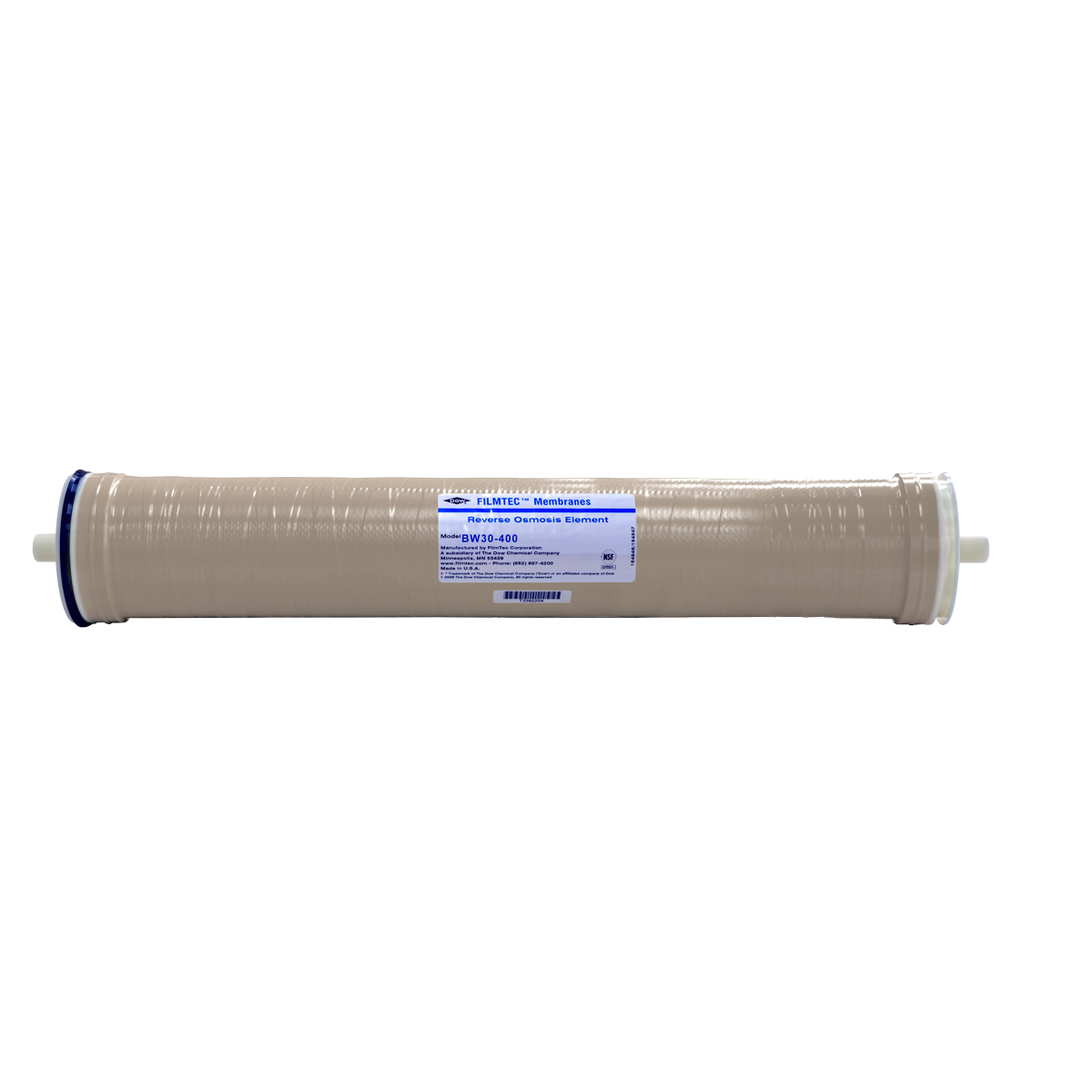

FilmTec™ BW30 PRO-400 Membranelement
Industriestandard-Membranelement für die Umkehrosmose von Brackwasser mit hohem Rückhaltevermögen und hoher Leistung
Wichtige Anwendungen
- Demineralisierung für industrielle Anwendungen, wie z.B.: Energieerzeugung, Stahl & Metall, Chemie & Petrochemie
- Kommunale Wasseraufbereitung
Typische Eigenschaften
- Nominale aktive Oberfläche - 37 m²
- Permeat-Durchflussrate - 42m3/Tag
- Stabilisierte Salzrückhaltung - 99,6%
- Minimale Salzrückhaltung - 99,4%
1. Permeatfluss und Salzrückhaltung basierend auf den folgenden Standardbedingungen: 2.000 ppm NaCl, 225 psi (15,5 bar), 77°F (25°C), pH 8 und 15% Rückgewinnung.
2. Die Durchflussraten für einzelne Elemente können variieren, liegen aber nicht mehr als 15% unter dem angegebenen Wert.
3. Die Verkaufsspezifikationen können im Zuge von Designüberarbeitungen variieren.
Empfohlene Betriebsbedingungen
- Membrantyp - Polyamid-Dünnschicht-Verbundwerkstoff
- Maximale Betriebstemperatur - 45°C 1
- Maximaler Betriebsdruck - 41 bar
- Maximaler Druckabfall - 1,0 bar 1
- pH-Bereich (kontinuierlicher Betrieb) - 2-11 1
- pH-Bereich (Kurzzeitreinigung =30 min) - 1-13 2
- Maximaler Zufuhrdurchfluss - 17m3/Std.
- Maximaler Zufuhr-Schlickdichte-Index - SDI 5
- Toleranz für freies Chlor 4 0,1 ppm
1. Die maximale Temperatur für den Dauerbetrieb über pH 10 beträgt (35°C).
2. Beachten Sie die FilmTec™ Reinigungsrichtlinien (Formular Nr. 45-D01696-de).
3. Empfohlene Feed- und Permeat-Durchflussraten, Flux und Rückgewinnung für verschiedene Feed-Quellen finden Sie in den FilmTec™ DesignGuidelines for multiple-element systems of 8-inch elements (Form No. 45-D01695-de).
4. Oxidationsschäden sind nicht durch die Garantie abgedeckt. DuPont empfiehlt die Entfernung von restlichem freiem Chlor durch eine Vorbehandlung vor der Exposition der Membran. Weitere Informationen finden Sie unter Entchlorung des Speisewassers (Formular Nr. 45-D01569-de).
Allgemeine Informationen
- Halten Sie die Elemente nach der ersten Befeuchtung stets feucht.
- Für einen erfolgreichen Betrieb von Umkehrosmose- (RO) und Nanofiltrations- (NF) Membransystemen muss der Betrieb den Richtlinien folgen, die im FilmTec™ ReverseOsmosis / Nanofiltration Elements Operation Excellence and Limiting Conditions Tech Fact (Form No. 45-D04388-de) angegeben sind.
- Um biologisches Wachstum während längerer Systemstillstände zu verhindern, wird empfohlen, die Membranelemente in eine Konservierungslösung zu tauchen.
- Der Kunde trägt die volle Verantwortung für die Auswirkungen von unverträglichen Chemikalien und Schmiermitteln auf die Elemente.
- Vermeiden Sie zu jeder Zeit einen statischen Gegendruck auf der Permeatseite.
- Permeat, das in der ersten Betriebsstunde anfällt, sollte verworfen werden.
- Die Verwendung dieses Produkts an sich garantiert nicht unbedingt die Entfernung von Zysten und Krankheitserregern aus dem Wasser. Eine wirksame Reduzierung von Zysten und Krankheitserregern hängt von der Gesamtkonzeption des Systems sowie vom Betrieb und der Wartung des Systems ab.
Regulatorischer Hinweis
Dieses Produkt kann in einigen Ländern Beschränkungen für die Anwendung im Trinkwasserbereich unterliegen. Bitte prüfen Sie vor der Verwendung und dem Verkauf den Anwendungsstatus.